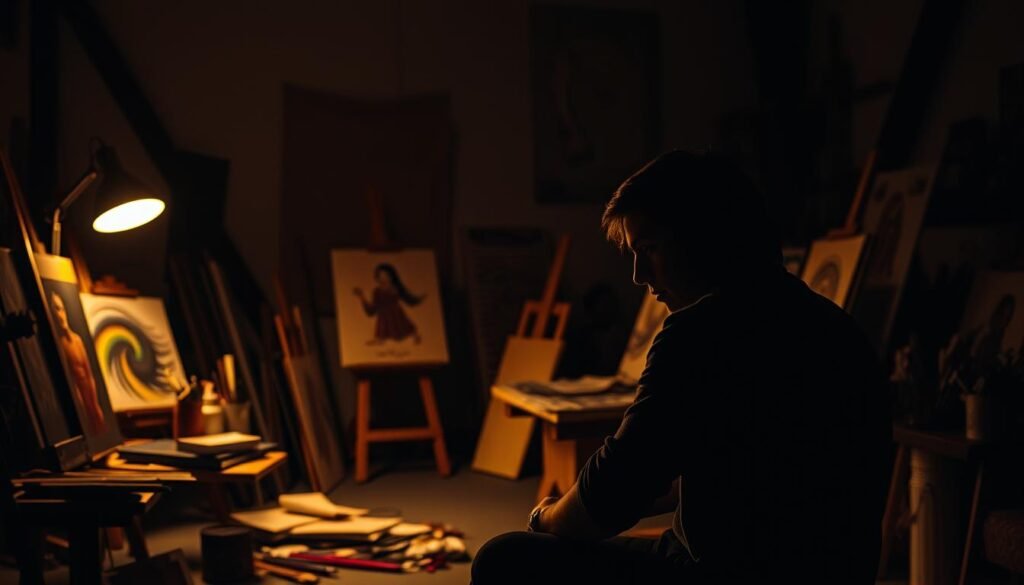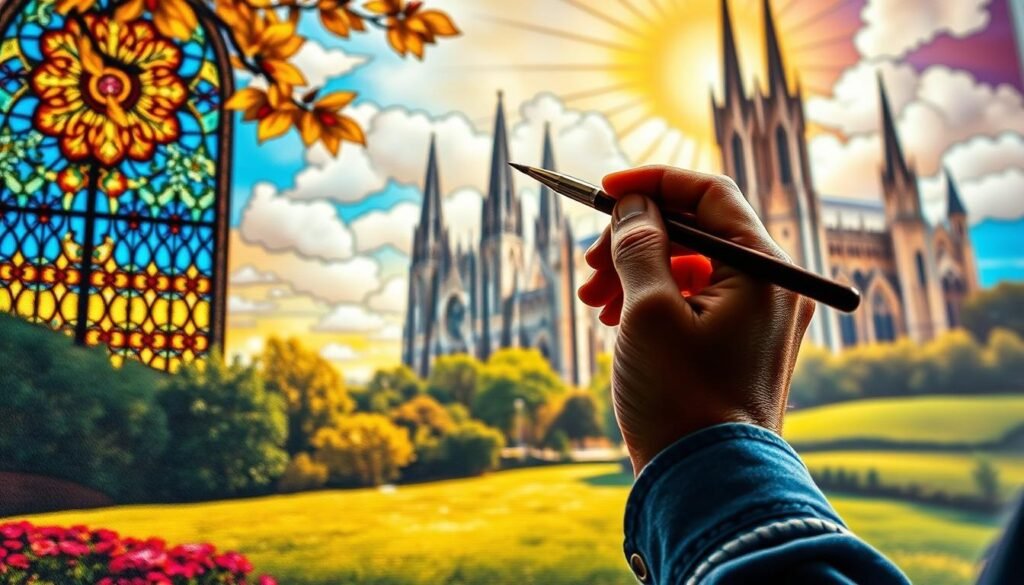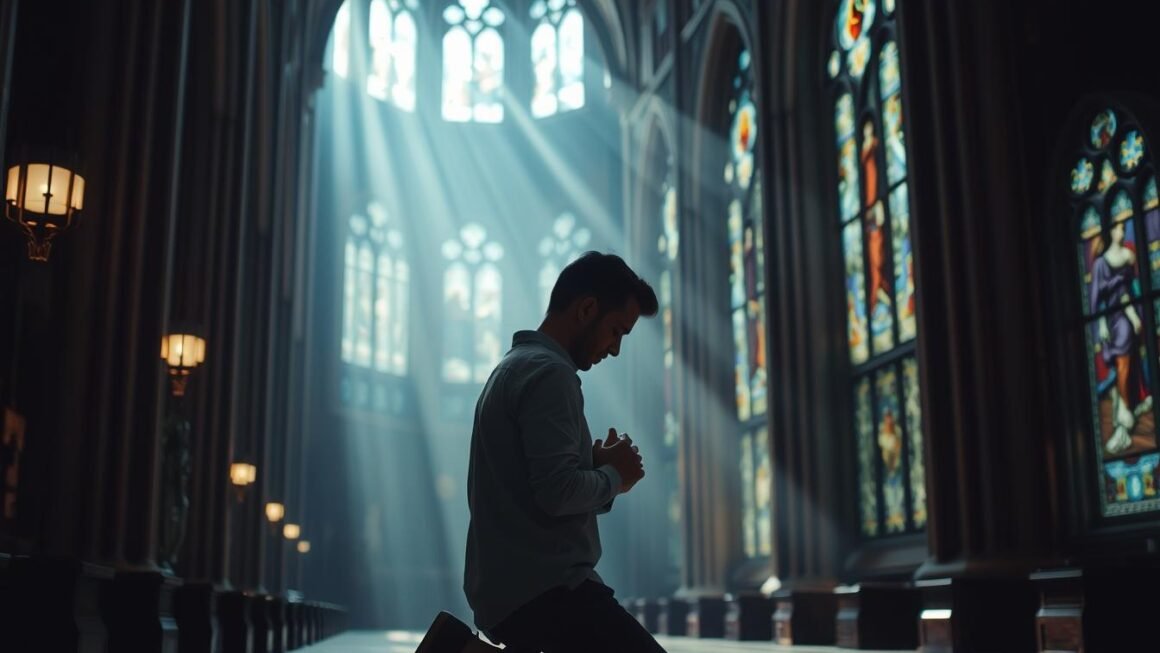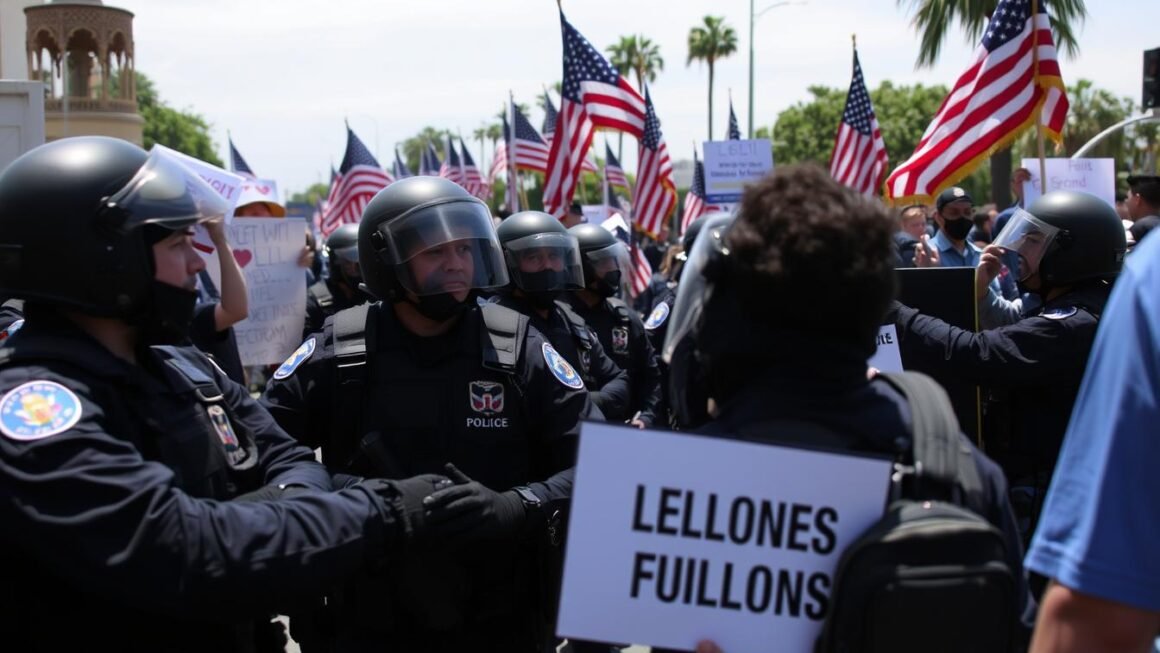I used to think “artistic expression and Christian faith” couldn’t mix. Churches didn’t seem to embrace art in the way galleries do. But my perspective shifted when I saw faith-inspired art at a service. It was so moving, and it connected me to God in a new way.
Creativity isn’t just okay in the Christian community; it’s celebrated! From murals to worship music, art makes our faith stronger. It lets us express our beliefs in new, exciting ways. So, let’s explore this creative side of spirituality together.
Key Takeaways
- Artistic expression has a profound impact on the understanding of Christian faith.
- Creative spirituality can deepen personal connections with God.
- Faith-inspired art showcases the richness of modern worship.
- Art and music together can transform worship experiences.
- The blend of creativity and spirituality fosters community engagement.
The Importance of Artistic Expression in Christianity
Let’s get real for a moment. When you hear “art and Christianity,” you might think of grand cathedrals or Renaissance paintings. But art in faith goes way beyond just pretty pictures. It connects us to God and each other.
Art is a special way to reflect on our spirituality. It gives us that “aha” moment that’s hard to find in regular worship.
Understanding Art as a Spiritual Reflection
Think of Christian art like your friend’s dance at a wedding. It might be awkward, but it’s full of heart. It’s how we show our deep faith with colors and creativity.
It could be a painter bringing divine inspiration to life, or a sculptor shaping religious beauty in stone. Each creation shares a unique devotion.
Historical Significance of Art in Christianity
Let’s take a trip back in history. Imagine early Christians in catacombs, using art to share their faith secretly. Art was essential for expression and connection, especially when speaking out was dangerous.
Throughout history, art has kept the faith’s stories alive. It shows us important Bible scenes and moments in history. Without it, we might have lost many important tales and truths.
Historical Overview of Christian Art
Christian art tells a story that spans centuries, showing how faith evolved. Artists found ways to express their beliefs, even in secrecy. Early symbols like the chi-rho and ichthys were clever faith signs.
The impact of famous artists is clear. They shaped art’s role in Christianity, making history along the way.
From Early Church Symbols to Renaissance Masterpieces
In the beginning, art was a secret chat with the divine. Symbols like the chi-rho and the fish helped believers connect discreetly. Then the Renaissance brought us Michelangelo and da Vinci.
These geniuses changed church walls into canvases of emotion and spirit. Their work shows how art and faith deeply connect, inviting us to ponder faith’s mysteries.
The Role of Art in the Early Christian Community
Art was key for early Christians, connecting them with stories and spirit. Creating under the radar, these artists aimed to inspire. Their legacy continues, sparking creativity in today’s Christian artists.
This community shows how art and belief weave together. Visual stories still echo faith’s power, drawing believers closer.
Artistic Expression and Christian Faith
Art adds a special touch to spirituality. It’s not just about looking good or adding music to silence. Through the mix of faith and art, worship becomes more than routine. It turns into something exceptional. Imagine being in a church and watching a live painting. Each stroke shows grace, love, and devotion.
The Interplay Between Faith and Creativity
Faith and creativity work wonderfully together. Using faith in creativity helps express beliefs in ways words can’t. Many artists are inspired by their faith. They use it to tell powerful stories through their work. This lets people see their faith in new and interesting ways.
How Art Enhances Worship Experiences
Art can make worship more engaging and personal. It can be through paintings, sculptures, or multimedia. These elements help deepen the connection with one’s faith. People become not just watchers, but active participants. They explore their beliefs together. Artistic experiences make Sundays special and uplifting.
Using art in worship changes how we see it. It brings people closer, both to each other and to their faith. When creativity is encouraged, communities grow stronger. People feel more connected to their spiritual lives.
The Evolution of Christian Music Genres
The sounds of Christian worship have dramatically changed. Traditional hymns are not the only choice anymore. These classics still matter, but now there’s more choice in Christian music. From contemporary tunes to rock, hip-hop, and metal, worship music has gotten more diverse.
Transitioning from Traditional Hymns to Contemporary Music
Traditional hymns were the foundation of Christian music. These songs were emotional and meaningful, helping to grow faith. But music has evolved with society. Contemporary Christian music brought new styles and lyrics. Now, music connects better with younger people. It’s great to see churches enjoying modern songs too.
Emergence of Diverse Music Genres in Christian Worship
Now, worship sessions are full of different styles of music. You might hear gospel pop or a touching worship ballad. This variety shows the many cultures of people who come together to worship. Music brings us all closer, no matter where we come from. Here’s a look at some main genres:
| Genre | Description | Examples |
|---|---|---|
| Contemporary Christian Music | Modern music with relatable lyrics aimed at worship. | Chris Tomlin, Lauren Daigle |
| Gospel | A lively genre with roots in African American spirituals. | Kirk Franklin, CeCe Winans |
| Rock | High-energy music that captures the spirit of worship. | Switchfoot, Skillet |
| Hip-Hop | Rhythmic and lyrical expression of faith in a contemporary style. | Lecrae, NF |
| Metal | A heavier sound that attracts a unique audience. | Underoath, Demon Hunter |
The mix of music genres makes worship more welcoming. Singing a modern anthem or grooving to a gospel song feels right. Welcome to a vibrant new way to worship. It’s anything but dull!
Impact of Musical Genres on Spiritual Experiences
Music has a powerful effect on our inner spiritual worlds. Styles from traditional hymns to contemporary praise each have their own charm. They get to our hearts in different ways. Music goes beyond just words, mixing personal tales with spiritual journeys. Now, let’s explore how various musical styles can spark change and influence our faith.
Personal Stories of Transformation Through Music
Many have felt music change their lives. A soft song in church might bring tears of connection for some. For others, lively gospel tunes can create a feeling of belonging with other worshippers. These stories show music’s power to transform, highlighting its deep significance.
How Different Genres Can Influence Faith Journeys
Different music styles and spirituality share a unique link. While traditional hymns can bring back memories, modern music might light a fire within us. Here, we examine how varied genres touch our faith journeys:
| Genre | Impact on Spiritual Experience | Typical Emotional Response |
|---|---|---|
| Traditional Hymns | Creates a sense of history and reverence. | Calm, reflective, nostalgic. |
| Contemporary Worship | Encourages community and active participation. | Excited, joyful, inspired. |
| Gospel | Expresses deep emotion and personal testimony. | Uplifted, empowered, connected. |
| Christian Rock | Challenges norms, fostering a rebellious yet faithful spirit. | Motivated, invigorated, passionate. |
Every genre brings something special to our faith through music. Whether it’s through inspiring anthems or soulful tunes, music is a key language of belief. It shows the many ways people walk their spiritual paths.
The Role of Religious Artistry in Modern Worship
In our fast-changing world, visual art in worship has gained a new and exciting role. It allows people to connect with their spirituality in ways that are both unique and deep. Think of how a mural or live painting can change how you feel during a service. It’s often a powerful, eye-opening experience. Religious art plays a key role in how we see and engage with our faith today.
Integrating Visual Art in Worship Services
Visual art is now more than just decoration in churches; it’s a path to deeper spiritual involvement. Churches are now bringing in all types of art. From huge murals that show important Bible stories to small, detailed works that touch on modern themes. Every artwork helps people feel closer to their spirituality. It gives them a chance to think about their own beliefs while they worship.
The Effect of Figurative Art on Spiritual Engagement
Let’s dive into figurative art. It’s more than just beautiful images. It sparks deep discussions about faith among those who see it. This type of art helps people see and feel stories and emotions connected to what they believe. Picture entering a place of worship filled with images of hope and rebirth. It’s like seeing your spiritual journey shown through art! Figurative art doesn’t just want you to look; it invites you to think, feel, and see your spirituality in a new light.
Contemporary Christian Artistic Movements
Art is more than just a beautiful sight or a tuneful song. It lights a unique spark within today’s art movements. This art is not what you’d find in an old church. It’s about prophetic art that changes how we see faith and creativity. Artists use bright canvases and mixed media, blending spirituality into art that touches modern believers deeply.
Prophetic Art and Its Significance Today
Prophetic art goes beyond making beautiful images. It’s like a spiritual conversation. Artists create works filled with divine inspiration. This lets people feel closer to their faith like never before. Imagine entering a place where art vibrates with God’s energy. That’s the wonder of prophetic art, making spirituality vibrant and captivating.
Innovative Approaches to Faith-Inspired Art
In today’s world, faith-inspired art is all about breaking norms. Artists play with different materials and methods to make art that’s an experience. They use interactive setups and digital art to draw us in. This isn’t art that just sits there. It’s alive, making us think and feel deeply about faith. Today’s artists are mixing creativity with spirituality in bold, new ways.
The Christian Artist Community
When you explore the Christian artist community, you find a world filled with creativity and faith. These two elements are tightly knit together. This community believes that making art is more than just a hobby; it’s a calling. Churches offer a supportive space for these artists to grow.
Supporting and Promoting Artists within the Church
Supporting artists in the church means doing more than just showcasing their work now and then. It involves setting up programs, workshops, and events. These activities help artists share their talents and work together on faith-inspired projects. Churches become places where artists can blend their faith with their art.
Building Relationships Between Art and Faith
Creating bonds between artists and church members brings a new depth to worship. When people see the work of local artists, they connect with their faith in new ways. Art opens up conversations and brings people together, blending imagination with spirituality. This fusion makes worship more personal and meaningful for everyone.
Challenges Faced by Christian Artists
Being a Christian artist is a journey of inspiration and conflict. You stand between the spiritual and the creative. This space often faces misunderstandings about faith in art. Some think faith-based art must fit a certain mold, which feels limiting. Let’s look at the hurdles Christian artists deal with.
The Misunderstandings Surrounding Artistic Expression
Many believe art should stick to biblical themes only. They overlook the vastness of artistic expressions. Emotions, stories, and personal views are valid in showcasing faith. Thus, artists may feel trapped, seeking their unique voice amidst these views.
They try balancing creativity with what’s expected by others. This struggle might lead to fears that their work will be misunderstood.
Balancing Personal Creativity and Theological Integrity
It’s a challenge to mix creativity with theological integrity. Artists aim to be original and true to their vision. Yet, they feel pressured to match their work with specific doctrines. This can limit their creative freedom.
Artists need bravery to stay true to their beliefs while being creative. Striving for this balance is tough but crucial for Christian artists.

Examples of Successful Integration of Art in Worship
Churches are finding new ways to mix art into worship. This brings fresh energy and meaning to services. The stories where art changed worship are truly uplifting for other groups.
Churches Embracing Unconventional Art Forms
Some churches now include more than just music or sermons. They use visual arts like paintings and videos to draw people in. This not only builds a stronger community but also makes worship more meaningful. Let’s explore some creative examples:
- City Church in Seattle features live mural painting during services, inviting congregants to witness art emerging in real time, reflecting themes of community and faith.
- Elevation Church in North Carolina integrates digital art and projection in their services to create immersive environments, allowing worshippers to experience the message visually and emotionally.
- The Metropolitan Museum of Art collaborated with local congregations to host installation exhibits that blend scripture with contemporary art, providing thought-provoking reflections on faith.
Stories of Transformative Worship Experiences
A small Texas church found success with visual storytelling. It helped them connect with younger members and brought everyone closer. This new path led to more people showing up and taking part.
In California, a church transformed a service into a performing arts festival. Drama and dance became ways for people to share their faith. This special service led to many saying they felt a deep, spiritual change.
| Church Name | Art Form Used | Impact on Congregation |
|---|---|---|
| City Church | Live Mural Painting | Increased engagement and community sense |
| Elevation Church | Digital Art and Projections | Enhanced emotional connections during worship |
| Small Church in Texas | Visual Storytelling | Resurgence in attendance and participation |
| California Church | Performing Arts | Spiritual breakthroughs and personal testimonies |
Scriptural Foundations for Music in Worship
Music has always been important in worship, dating back to biblical times. You don’t need an expert to see that the Bible mentions music a lot. It shows us how music is key in showing faith and love for God. The Bible is full of moments that ask us to sing, use instruments, and dance to celebrate God’s kindness. This makes music in worship very powerful, offering deep spiritual experiences beyond just tunes.
Examining Biblical References to Music and Worship
The Bible could be seen as a collection of worship songs. For example, Psalm 100 brings shouts of joy, while Psalm 137 shares deep sadness. Each psalm lets us glimpse into worship’s emotional world, highlighting the power of music and song in connecting us with God. Events in the Bible, like the Israelites celebrating freedom with song and dance, show how music and worship are linked.
Some key verses that emphasize music in the Bible include:
| Reference | Theme | Context |
|---|---|---|
| Psalm 150:4 | Musical Instruments | Encouragement to praise God with variety of instruments. |
| Colossians 3:16 | Singing in Community | Admonition to let the message of Christ dwell richly, expressed through singing. |
| 1 Chronicles 16:23 | Joyful Noise | Call to declare God’s glory through song. |
These passages are more than history; they guide us in using music as worship today. They inspire us to explore our faith creatively. By doing this, we honor God with our joy, tears, and all feelings in between. These biblical truths about music help us feel closer to God and to each other, making a rich community of shared faith.
The Role of Art in Communicating the Gospel
Art speaks to us deeply. It uses visuals to share the Gospel, cutting through language and culture. Think of stained glass windows or biblical paintings. They share spiritual truths and start faith conversations.
Visual Imagery as a Tool for Evangelism
Art changes how we present the Gospel. Artists use visuals to spark thought and dialogue. A mural of the Good Samaritan might spark talks on kindness. This artistic approach raises curiosity and reaches hearts differently than words.
The Emotional Impact of Art on Believers
Many remember when art moved them or connected them to something bigger. This emotional impact brings believers together. Viewing art, one might see their own story, making their faith more personal.

Art in worship links us emotionally, enriching group and personal faith experiences. Different art forms touch various emotions, deepening faith understanding. These efforts show evangelism’s heart is in sharing vivid stories that touch us deeply.
| Art Form | Purpose in Evangelism | Emotional Engagement |
|---|---|---|
| Painting | Visual storytelling of biblical narratives | Evokes personal reflection and inspiration |
| Photography | Captures real-life faith moments | Creates relatable connections to everyday life |
| Sculpture | Depicts significant spiritual symbols | Engages viewers through tactile and visual presence |
| Murals | Transforms community spaces with spiritual themes | Fosters a shared sense of belonging through public art |
Art and evangelism connect beautifully, showing creative work’s role in faith. Art tells stories that strengthen spirit and community bonds, leading to deep belief and hope discussions.
Promoting Figurative Christian Art Today
In the world of faith, figurative Christian art is very important. It does more than just look good. It helps build a strong culture where art has deep meaning. Exhibitions are great for showcasing artist talents and bringing people together. They give the community a chance to enjoy and connect with art. And yes, art plays a big role in how we understand and feel about our faith. It helps us see our beliefs in new ways and brings us closer together.
Exhibitions and Community Engagement
Exhibitions are a great way for artists to show their work. They can happen in galleries or even in churches. Each place has a different feel for displaying art. These exhibitions do more than just show art. They create lively spots where people can meet and share ideas. Here’s why getting together like this is important:
- It starts conversations about faith and creativity.
- It brings different people together to share in the experience.
- It shows us how art is important in our world today.
Supporting Emerging Artists in the Faith Community
It’s important to support new artists in the faith community. While famous artists are already well-known, the new ones bring new ideas. By supporting them, we might help find the next big Christian art piece. Here’s how we can support emerging talent:
- Have workshops where they can show what they can do.
- Give them chances to learn from experienced artists.
- Help them get their art shown in places where the community can see it.
Conclusion
Creativity is more than making art or catchy tunes. It’s about diving deep into our souls. It allows us to connect with God in unique ways. The stories we’ve seen show that faith-based art creates a strong divine connection. This changes how we see worship and community.
Think about your faith journey. How could you be more creative? Trying out painting, playing music, or doodling in your Bible are all good starts. Each creative act brings us closer to understanding our spirituality. Our unique abilities can highlight faith in ways that speak to different people.
Art’s power is often underestimated. But we shouldn’t hold back our talents. Embrace your creativity’s diversity, quirks, and even its awkward moments. Every piece of art or music can be an expression of your faith. It can be freeing and change lives. So, create with joy, use bold colors, and let your creativity show your faith’s beauty!



